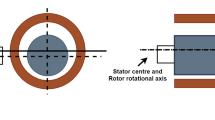Abstract
To study the influence of skewed rotors and different skew angles on the losses of squirrel cage asynchronous motors, a 5.5-kW motor was taken as an example and the multi-sliced field-circuit coupled time stepping finite element method (T-S FEM) was used to analyze the axially non-uniform fundamental and harmonic field distribution characteristics at typical locations in the stator and rotor cores. The major conclusions are: firstly the skewed rotor exhibits a decrease in the harmonic copper losses caused by slot harmonic currents in the stator winding and rotor bars. Secondly, the skewed rotor shifts the non-uniform distribution of field in the axial direction, which leads to more severe saturation and an increase in iron losses. The heavier the load, the more pronounced the increase in iron losses. Furthermore, the influences of different skew angles on motor losses are studied systematically, with skew angles from 0.5 to 1.5 stator tooth pitch. It is found that the lowest total loss occurs at 0.8 stator tooth pitch, and the slot harmonics can be decreased effectively.
Similar content being viewed by others
References
Chen S K. Electrical Machines Design (in Chinese). Beijing: China Machines Press, 2008. 275–277
Williamson S, Flack T J, Volschenk A F. Representation of skew in time-stepped two-dimensional finite-element models of electrical machines. IEEE Trans Ind Appl, 1995, 31(5): 1009–1015
Jiang J Z, Fu W N. Multi-slice finite element analysis of skewed induction motors (in Chinese). Trans China Electrotech Soc, 1997, 12(5): 11–17
Urresty J C, Riba J R, Romeral L, et al. A Simple 2-D finite-element geometry for analyzing surface-mounted synchronous machines with skewed rotor magnets. IEEE Trans Magn, 2010, 46(11): 3948–3954
Gyselinck J J C, Vandevelde L, Melkebeek J A A. Multi-slice FE modeling of electrical machines with skewed slots-The skew discretization error. IEEE Trans Magn, 2001, 37(5): 3233–3237
Kawase Y, Yamaguchi T, Tu Z P, et al. Effects of skew angle of rotor in squirrel-cage induction motor on torque and loss characteristics. IEEE Trans Magn, 2009, 45(3): 1700–1703
McClay C I, Williamson S. The variation of cage motor losses with skew. IEEE Trans Ind Appl, 2000, 36(6): 1563–1570
McClay C I, Williamson S. Influence of rotor skew on cage motor losses. IEE Elect Power Appl, 1998, 145(5): 414–422
Kown B I, Kim B T, Jun C S. Analysis of axially non-uniform loss distribution in 3-phase induction motor considering skew effect. IEEE Trans Magn, 1999, 35(3): 1298–1301
Kalokiris G D, Kefalas T D, Kladas A G, et al. Special air-gap element for 2-D FEM analysis of electrical Machines accounting for rotor skew. IEEE Trans Magn, 2005, 41(5): 2020–2023
Dorrell D G, Holik P J, Rasmussen C B. Analysis and effects of inter-bar current and skew on a long skewed-rotor induction motor for pump applications. IEEE Trans Magn, 2007, 43(6): 2534–2536
Dorrell D G, Holik P J, Lombard P, et al. A Multisliced finite-element model for induction machines incorporating interbar current. IEEE Trans Ind Appl, 2009, 45(1): 131–141
Zhao H S, Luo Y L, Liu X F, et al. Analysis on no-load iron losses distribution of asynchronous motors with time-stepping finite element method (in Chinese). Proc CSEE, 2010, 30(30): 99–106
Zhao H S, Liu X F, Hu J, et al. The influence of wye and delta connection on induction motor losses taking slot opening and skew effect into account. IEEE IEMDC, Miami, USA, 2009. 213–218
Zhao H S, Liu X F, Luo Y L, et al. Losses characteristics of cage induction motors under voltage deviation conditions (in Chinese). Electric Mach Contl, 2010, 14(5): 13–19
Bertotti G. General properties of power losses in soft ferromagnetic material. IEEE Trans Magn, 1988, 24(1), 621–630
Cheng S K, Pei Y L, Zhang P, et al. Fundamental research on the third function of rotating electric machine. Trans China Electrotech Soc, 2007, 22(7): 12–17
National Rotational Electrical Machines Standardization Technical Committee. GB/T 1032-2005. Test procedures for three-phase induction motors (in Chinese). Beijing: Standard Press of China, 2005. 6–7
Cui X S, Luo Y L, Yang Y L, et al. Energy saving theory and approach for asynchronous motor under the periodically variable running condition (in Chinese). Proc CSEE, 2008, 28(18): 90–97
Author information
Authors and Affiliations
Corresponding author
Rights and permissions
About this article
Cite this article
Zhao, H., Liu, X., Luo, Y. et al. Time-stepping finite element analysis on the influence of skewed rotors and different skew angles on the losses of squirrel cage asynchronous motors. Sci. China Technol. Sci. 54, 2511–2519 (2011). https://doi.org/10.1007/s11431-011-4433-x
Received:
Accepted:
Published:
Issue Date:
DOI: https://doi.org/10.1007/s11431-011-4433-x




